LADAKH - LAMAYURU to CHILLING TREK
Tour - 10 days/ 5 days trekking
LAMAYURU to CHILLING TREK
Tour - 10 days/ 5 days trekking
About LADAKH
Ladakh is a part of the Indian Himalayas It is located between the Kunlun mountain range in the north and the main Himalayas to the south. Although part of India now, and earlier of the princely state of Kashmir, Ladakh has been an independent kingdom for almost 900 years.
Ladakh is well-known for its starkly beautiful mountain scenery. As a result of its location in the rain shadow of the main Himalayan Range its climate is extremely dry, and due to the high altitude – most valleys are situated at 3300m or higher – winters can be extremely cold. Summers, however, are generally pleasant if not warm and sunny. Ladakh is inhabited by a mix of Indo-Aryan and Tibetan people. Especially the latter, with their colourful buddhist culture, have given the region the nickname of ‘Little Tibet.’
Ladakh in the narrower sense is the Indus Valley with adjacent areas. It is bordered by two mountain ranges: in the northeast by the Ladakh Range, in the southwest by the Zanskar Range. The area around the capital Leh, and further upstream towards Tibet, is referred to as Upper Ladakh. Lower Ladakh is the area further downstream to Kargil, where the Indus enters Pakistan.
The remoter areas of Zanskar, Nubra and Rupshu are now seen as regions of Ladakh. In the past, these areas were sometimes part of Ladakh, sometimes not. They can be visited from Leh by car or on foot. The latter would be your means of transport, if you are up to it. Because, while jeep trips in Ladakh are very rewarding indeed, trekking will give you an even in-depth experience of the land and the people, with the added bonus of a total renovation of body and soul.
Ladakh can be reached by air or overland. On this tour you fly in and out. In case you have enough time available, we strongly recommend to take the overland route, in which you travel by train and car to Ladakh through Manali, in the Himalayan state of Himachal Pradesh. This is one of the greatest car journeys in the world.
Region
Ladakh
(India)
Best Time
July - Sept.
No. Of Days
10 days,
5-day trek
Trip Character
Trekking tour
Sleeping Altitude
3500 - 4480 m.
Trek Character
Camping trek
Level: 2 / 3
Price
INR XXX/ $ XXX
ABOUT THIS TOUR
This is one of the most rewarding and complete trekking routes in Ladakh. The Lamayuru-Chilling trek combines well known and very little visited places and shows you beautiful traditional villages as well as awe-inspiring mountain vistas.
The first part of this trek is very little known and therefore not yet popular. Starting from Sham Sumdo, not far from Hemis Monastery, it takes you along the slopes of the Stok Range (part of the Zanskar Range) along high altitude meadows and passes that rarely see an outsider You basically skirt the south side of the Zanskar Range without crossing it for 4 days. Then, you cross the Stok La (4800m) to Rumbak, a well-known but picturesquely situated village.
Here, you pick up the traditional Markha Valley trek, crossing the Ganda La (4900m) to the small but beautiful village of Shingo, and on to the Markha Valley. Here, where everyone else turns left, we go right, cross a bridge over the Zanskar River at Chilling and continue from there on the Chilling to Lamayuru trek. Two high passes and a minor one, and four traditional villages lie between start and end. Especially reaching Sumdah Chenmo, a village unconnected by roads, will give you a ‘time-warped’ feeling. Lamayuru, the endpoint of the trek, is the site of one of Ladakh’s most enigmatic gompas (monasteries) and a very worthy closure of this complete and varied trek.
The Lamayuru-Chilling trek is best done with tents. At some parts sleeping at homestays is also possible (and recommended for one or two days for the experience) but as horses, cooks etc. have to come along anyway, this does increase the cost.
YOUR custom-made TRIP
The tour described here, as well as the other ones on our website, are mainly meant as suggestions. We would be happy to offer you a travel proposal that fully meets your personal demands and expectations. That means that you choose where you want to go, what level of accommodation and type of transport you want and what activities you prefer.
Please let yourself be inspired by this and other trips on our website and then drop us a line (or call us up) to explain your travel wishes. We will be happy to help you put together the perfect trip. You can send us an e-mail or call us over Whatsapp.
EXTENSIONS & VARIATIONS
Apart from the tour as described here, you could consider the following add-ons and changes:
- Extend the trek from Chilling into the Markha Valley, then over the Ganda La pass (3900m), past picturesque Rumbak and on over very little visited yak meadows on southern slopes of the Zanskar Range till Shang Sumdo. For this you need another 7 or 8 days but it is utterly rewarding. See here.
- Do a 6-day exploration by car to the beautiful and little developed Nubra Valley and magnificent Pangong Tso, a lake at 4250m on the Tibetan border. See here.
- Spend a day rafting on the Indus. There are different grades available, so there is the easy but fun to do level as well. Professional oarsmen will be with you in any case. You will be picked up from your hotel and dropped off there again at the end of the day, a pic-nic lunch is included.
ITINERARY
-
.fa-info {color: #1146a9;}.fa-info:hover {color: #387dff;}Day 1: Flight Delhi - Leh
The flight from Delhi to Leh takes only 1 hour but on a clear day, is breathtaking. Stepping down from the aircraft you may feel the altitude, but even if you don’t, it is very wise to take the rest of the day off. Stay at the hotel or at best walk around Leh bazar. Altitude 3500m. -
Day 2 & 3: In Leh
If you wake up today without a headache you may consider yourself fit to go on not too strenuous walks/excursions in and around Leh. Else it is better to stay at the hotel another day. Altitude 3500m. -
Day 4: Leh - Lamayuru (3.5 h)
Following the Indus downstream, you'll visit the ancient monasteries of Alchi and Likir, and eventually picturesque Lamayuru Gompa, a monastery perched on a cliff overlooking a stark 'moon land' of brightly coloured mountain slopes. The monastery has numerous intricate wall paintings. Your hotel overlooks the monastery. -
Day 5: Trekking Lamayuru - Wanla (4 - 5 h)
You climb out of the valley, following a winding trail climbing steadily towards the Prinkiti La pass (3725m) and then gradually slopes down to the villages of Shilla and Wanla. Altitude 3500 → 3725 → 3150m. -
Day 6: Trekking Wanla - Hinju (5 - 6 h)
A walk through an arid and barren valley takes us to the small village of Phenjila from where the trail climbs up into another valley besides the Ripchar River to Hinju. Altitude 3150 → 3785m. -
Day 7: Trekking Hinju - Konske La - Sundah Chenmo (7 h)
The trail ascends steeply towards the Konske La pass (4900m), where you are met with extensive views of glacier-capped peaks and sweeping barren valleys dotted with splashes of green. The trail down leads to the village of Sumdah. Altitude 3785 → 4950 → 4400m. -
Day 8: Trekking Sumdah Chenmo - base Dundunchen La (5 - 6 h)
After a further descend towards the tiny village of Lanak at 3750m, a steady climb leads to yak meadows at the base of Dungdungchen La. Altitude 4400 → 4600 → 3100m. -
Day 9: Trekking base Dundunchen La - Dundunchen La - Chilling & car to Leh
It's steady climb to the Dungdungchen La (4600m). Just after the pass you are rewarded with glorious views of the Zanskar River gorge. A long descent leads to the village of Chilling, known for its fine metalwork. The car awaits you here for the drive back to Leh. Altitude 3600 → 4300 → 3200 → 3600m. -
Day 10: Flight Leh - Delhi
After breakfast, you will be transferred to the airport for the flight back to Delhi.
HIGHLIGHTS OF THIS TOUR
Flight to Leh
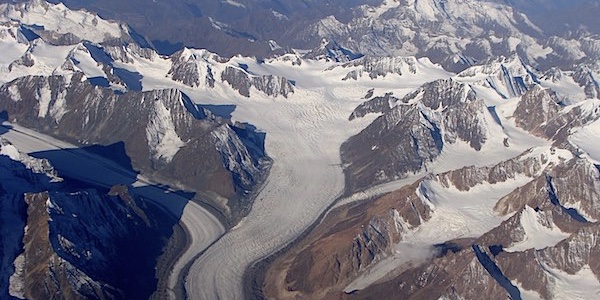
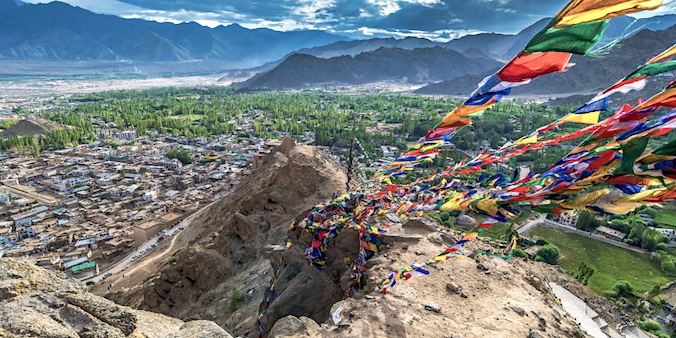
LEH
CARAVAN ROADS OF LADAKH
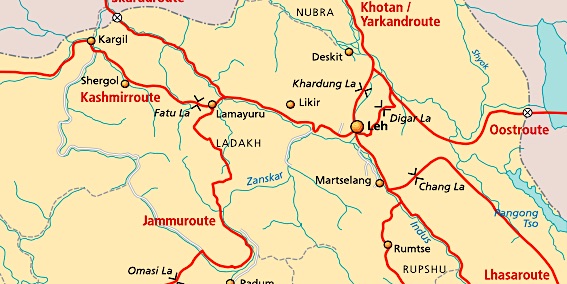
LOWER INDUS VALLEY (WEST)
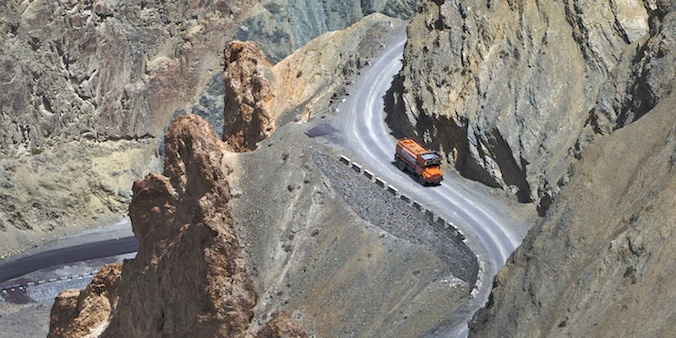

LAMAYURU & ALCHI GOMPA
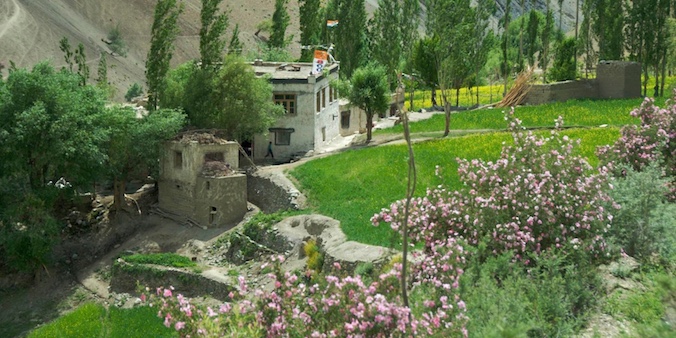
Trek Lamayuru - Chilling
The trek can be characterized as the shortest serious trek in Ladakh. It can be done in 4 or 5 days. In these days you’ll climb over two serious passes. You’ll pass several small, semi-traditional or fully traditional Ladakh villages, where the people still live of the land and the animals they keep. Life is hard and simple here, with little modern world facilities other then a television. The basic principle, here, is still self-sufficiency, in all respects. The first encounter with a Ladakhi from one of these villages will probably tell you this ‘lifestyle’ does no make the people unhappy. On the contrary, the vast majority of the Ladakhi villagers are a contented lot, deeply rooted in their culture and Buddhist beliefs.
